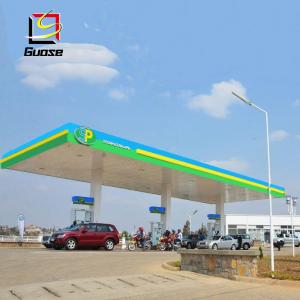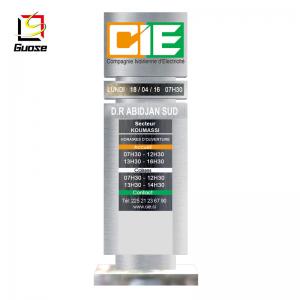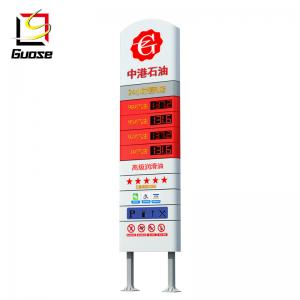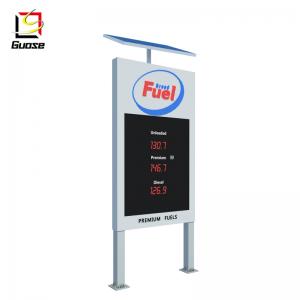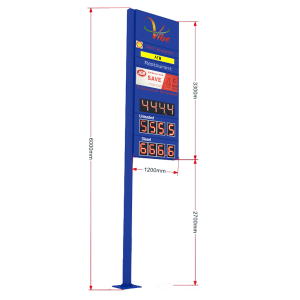Guose a gas station construction company to negotiate the basic requirements for gas station construction
Car gas stations operate special products that are flammable and explosive. According to the characteristics of retail operation services, 24 hours and nights service is required. At the same time, the gas station is located in a convenient location for the whole society. Although the construction scale is not large, it is “completely complete”. In response to these characteristics, some basic requirements should be in the construction of gas stations.
First, the classification of gas stationsGasoline stations have different tank capacities, and their business volume is different. The degree of danger and the degree of influence on surrounding buildings are also different. According to the "Code for Design and Construction of Automobile Refueling and Gas Filling Stations", gas stations are generally divided into first-class stations, second-level stations and third-level stations. No first-class gas stations should be built in urban built-up areas, and direct-buried underground horizontal oils should be used. Tanks, considering the urban land shortage, urban gas stations should be built three-level stations. The scale of the stations at all levels and the control of land use are shown in the table below.
In addition to the above three grades of gas stations, gas stations can be divided into onshore gas stations, water filling stations and aerial gas stations according to different locations and service targets. The onshore gas station is equipped with refueling equipment on the land, mainly for motor vehicles: on the refueling, the refueling equipment is set on the dock or on the ship, mainly for the motor boat on the water; the air station is not available in China. Foreign airlines have) mainly provide services for all types of aircraft flying in the air. The refueling equipment is installed on aircraft that specialize in refueling equipment.
Second, the function requirements of the gas station
Any project should be based on functions and divided into several components for comprehensive analysis. For gas stations, the main function is to quickly, accurately and safely refuel all kinds of motor vehicles. In order to meet this specific functional requirement, it is necessary to consider the construction of the gas station from the beginning of the design to meet the needs of various vehicle refueling. It should be from the surrounding environment, site selection, size, traffic conditions, layout, user convenience and even water intake. Drainage, power lighting, communication, environmental protection and other aspects are given comprehensive consideration. Each part has its own specific function, and there is no need for a part that has no function or function. Therefore, the purpose of functional analysis is to determine the function of each component from the overall functional requirements, and the functions of the components must be consistent. For example, some gas stations are built away from traffic trunks or on the side of the road where vehicles are inconvenient and inconvenient, causing a lot of inconvenience to refueling the car, resulting in unreasonable use. Another gas station, although the design scale is large, the decoration standard is higher, and the investment is much more, but because the internal use function of the gas station is not complete, it is often necessary to rebuild and reinvest after the completion of the construction. The above examples show that before the construction of the gas station, due to the lack of attention to the use of the gas station, blind construction, resulting in adverse consequences.
When formulating the functional standards of gas stations, we must also pay attention to the differences between different places and regions. Due to the different climate, environment, transportation, geography, customs and customs, the functional requirements for gas stations should be different, but The general functional requirements of application, economy, aesthetics, safety and reliability should be consistent.
Third, transportation requirements
Car gas stations, as the name suggests, are fueling cars. Therefore, the site of the gas station must be selected on the side of the main road, and the car is more frequent. The venue should be wide, easy to enter and exit, and there are no obstacles on both sides to block the line of sight. The target is eye-catching so that the driver can clearly see the gas station from a distance to improve the competitiveness of the fueling service.
At present, in the design of transportation and roads in China, the municipal road traffic lines are divided into two forms: one is the commonly used parallel distribution form; the other is the mixed distribution form of parallel and vertical phase. These two forms of traffic distribution not only ensure the traffic connection between the city center and the city, but also serve to collect the traffic flow at the district level to the city center.
The transportation of gas stations is composed of space nodes (square intersections or crossroads) and traffic channels in the spatial structure. Its optimal composition is network-like, which ensures smooth traffic and promotes the prosperity of the fueling business. However, gas stations should not be built in densely populated urban commercial areas and traffic jams, so as not to affect traffic.
In short, the construction of gas stations should be compatible with the development of transportation. In the choice of site, it must be conducive to traffic management, and can not ignore the traffic requirements and consider the construction of gas stations separately. For example, a gas station in a city is built near an overpass, with a large number of vehicles and fast speeds. Cross-contradictions between refueling vehicles and normal vehicles often cause traffic accidents, hinder traffic, block roads, and disrupt normal traffic order.
Fourth, gas station safety, fire, explosion-proof requirements
Different from ordinary industrial buildings, automobile gas stations have the characteristics of fireproof, explosion-proof, lightning protection and anti-static requirements, so safety work is particularly important. According to the difficulty of ignition of the oil, the oil products in the gas station are classified into Class A, B and C according to their closed flash points, so as to stipulate the relevant safety distance and fire protection requirements respectively.
Gasoline is an oil with a flash point below 28 °C. It is most volatile, and it is easy to form an explosive mixture around it. It will cause explosion or burning in the event of an open flame. In the fire accident investigation, such oil fires accounted for 70%, and many oil station fire accidents were caused by almost all such oil products. Therefore, oils with a flash point below 28 °C are classified as the most dangerous category A.
Lamp kerosene and -35 light diesel oil are more likely to cause fire or explosion. The flash point of these oils is higher than 28 ° C and lower than 60 ° C, so this type of oil is classified as Class B.
The flash point of light diesel oil (No. 0 and No.-10) is higher than 60 ° C. Under normal environmental conditions, explosive mixed gas cannot be formed around it, so it is not easy to catch fire or explode. In the gas stations operated, the storage temperature of such oils is not high, and no fire or explosion has occurred. Therefore, oils with a flash point higher than 60 ° C are classified as Class C.
In some of the refueling and chemical companies' auxiliary oil depots, there have been several accidents due to excessive storage temperatures of light diesel oil, heavy diesel oil and some heavy oil. The flash point of these oils is above 60 ° C and below 120 ° C. Lubricating oil with a flash point higher than 120 °C and heavy oil No. 200 are difficult to ignite. There has not been a fire accident caused by such oil in China. Therefore, Class C oil products are classified into two categories, C-A and C-B.
In summary, the more dangerous in the gas station is gasoline, which is classified as a Class A oil. In some local fire departments or urban planning departments, in order to avoid fires at gas stations and ensure the safety of neighboring enterprises or residents, it is required to build gas stations in remote places. In fact, the probability of fires at gas stations is very low. According to the investigation of gas stations in most provinces, municipalities and autonomous regions in the country, most of the fires at gas stations are caused by a small amount of oil spilling on the ground. Very few of them are caused by the fire of fuel tanks of cars or motorcycles. An example of a gas station underground oil tank catching fire or a fuel dispenser igniting an adjacent enterprise or residential building was discovered. So the gas station is not as dangerous as the oil depot. The gas station has less oil storage, and it is also a underground tank, with less oil and gas, which is safer. As long as the requirements of the “Code for Fire Protection of Building Design” and “Design Specification for Automobile Refueling and Gas Stations” ensure the distance between the gas station and the adjacent enterprise or civil building, there is no danger. However, it should be emphasized that the operation is not forgotten, and the gas station is more dangerous than other commodities. It is necessary to have a special person to manage safety. It will negotiate with the relevant departments such as safety firefighting, check and implement it frequently, and solve the problems that may be encountered before the construction of the station or before the accident, to prevent future problems. Summarize past experience and lessons, take the lead and guarantee safety services.
V. Gas station building modeling requirements
Since the gas station is generally located in the main road, the design point is arranged along the road, and the geographical position is more obvious. Although its scale is small, it is of great significance to beautifying the streetscape. In the past, some cities did not pay enough attention to the design of gas stations, and simply pursued operating profits, making the design of gas stations not good, affecting the style of urban construction. The planning and design of the gas station should start from the landscape analysis of the surrounding environment and formulate a planning and design plan that is practical, rational and artistic. Practicality requires gas stations to have various resilience capabilities to facilitate refueling, to deal with the relationship between individuals and groups, new and old, local and overall, near-term and long-term, gas station construction and economic construction; rationality requires refueling services with high quality The operation and production environment, that is, the layout is reasonable, the facilities are matched, the traffic is convenient, and the environment is coordinated; the artistic requirements require that the gas station has a unique architectural style, and the greening, advertising, etc. must have distinctive gas station characteristics, local characteristics and strong artistic appeal. .
In short, the construction of the gas station requires that while creating the architectural space and artistic conception, we must pay full attention to the shaping of the architectural image. The design can be used in a simple way to give the building a strong sense of rhythm. The height of the façade is high and low, and the gas station and the business hall of the gas station echo back and forth. In the virtual and real contrast processing, we should pay full attention to enhance the sense of centripetality, through the combination of volume and elevation; form a pattern of symmetrical or asymmetrical equilibrium. Bright colors are united with rhythmic shapes. In terms of scale and local treatment, we must also give people a feeling of kindness and liveliness. The gas station with no environmental landscape effect, unsatisfactory facilities, rough design, low functional quality, and uniform construction style can not keep up with the requirements of the current economic development, and the city gas station can still get rid of the "everyone knows". Dilemma.
Sixth, gas station environmental protection requirements
Environmental protection is a basic national policy of our country. If there is no gas station in the city, we must not forget the environmental protection. Therefore, in the construction process of gas stations, it is necessary to take appropriate technical measures to prevent oil leakage and bring harm to the environment. The pollution source of the gas station mainly has the following two aspects: when the fuel is refueled, the oil is dripped on the ground. Generally, the light oil is quickly volatilized and dissipated in the air. The residual oil is wiped clean with a mop according to the operating procedures, and washed with water. And the water washed by the mop is poured into the simple grease trap; when the underground storage tank of the gas station stores the oil, the water cut operation is generally not performed, but only when the oil tank is overhauled and cleaned, more oily sewage is discharged. . This kind of intermittent drainage requires a complete set of oily sewage treatment facilities, which is not economically economical and it is actually unnecessary to do so. Simple sewage treatment methods should be adopted according to the situation, such as brick three-section grease trap and various mobile wastewater treatment machines, so that the treated sewage meets national emission standards. In addition, it is necessary to pay attention to the leakage of various valves in the gas station. Once it appears, it should be replaced or treated in time. To do a good job in environmental protection, we must be at the forefront of the design and operation of gas stations. Improve environmental protection facilities and create a beautiful working environment for gas stations. This not only can cultivate people's sentiments, remove pollution, and enjoy spiritual enjoyment. What is more important is that when drivers drive into gas stations, they feel open and comfortable. Coupled with the quality service and efficient work style of the gas station, the driver is left with a good impression. This is an intangible and far-reaching social benefit and an important factor in the development of business operations.
Seven, gas station comprehensive operational requirements
Promoting integrated operations is the basic policy for gas stations to adapt to the market economy, enhance their resilience and exert their commercial potential. At present, in the oil product sales industry, the output value of non-oil products operations has accounted for more than 10% of the total output value of oil products, and profits have accounted for more than 20%. Some gas stations with good comprehensive operations have accounted for more than 40% of the output value of non-oil products. Oil companies not only sell oil products, but also carry out car wash and car repair services. At the same time, they sell auto parts, daily small commodities, and even operate restaurants, hotels, etc., which are convenient for users and increase economic benefits. In the implementation of the comprehensive management strategy, we should also see the shortage of petroleum resources, determine the contradiction of the demand for refined oil products, and make the supply of refined oil products have a large gap every year. Under this new situation, gas stations do not engage in integrated operations, and they do not have the vitality to expand their business scope. In addition, the location of the gas station is generally better, the vehicles come to the south, the users have a variety of needs, objectively have the advantage of engaging in diversified operations. In short, gas stations must constantly adapt to market needs, update their concepts, rely on advantages, engage in business development and engage in supporting services, and vigorously develop integrated operations.








